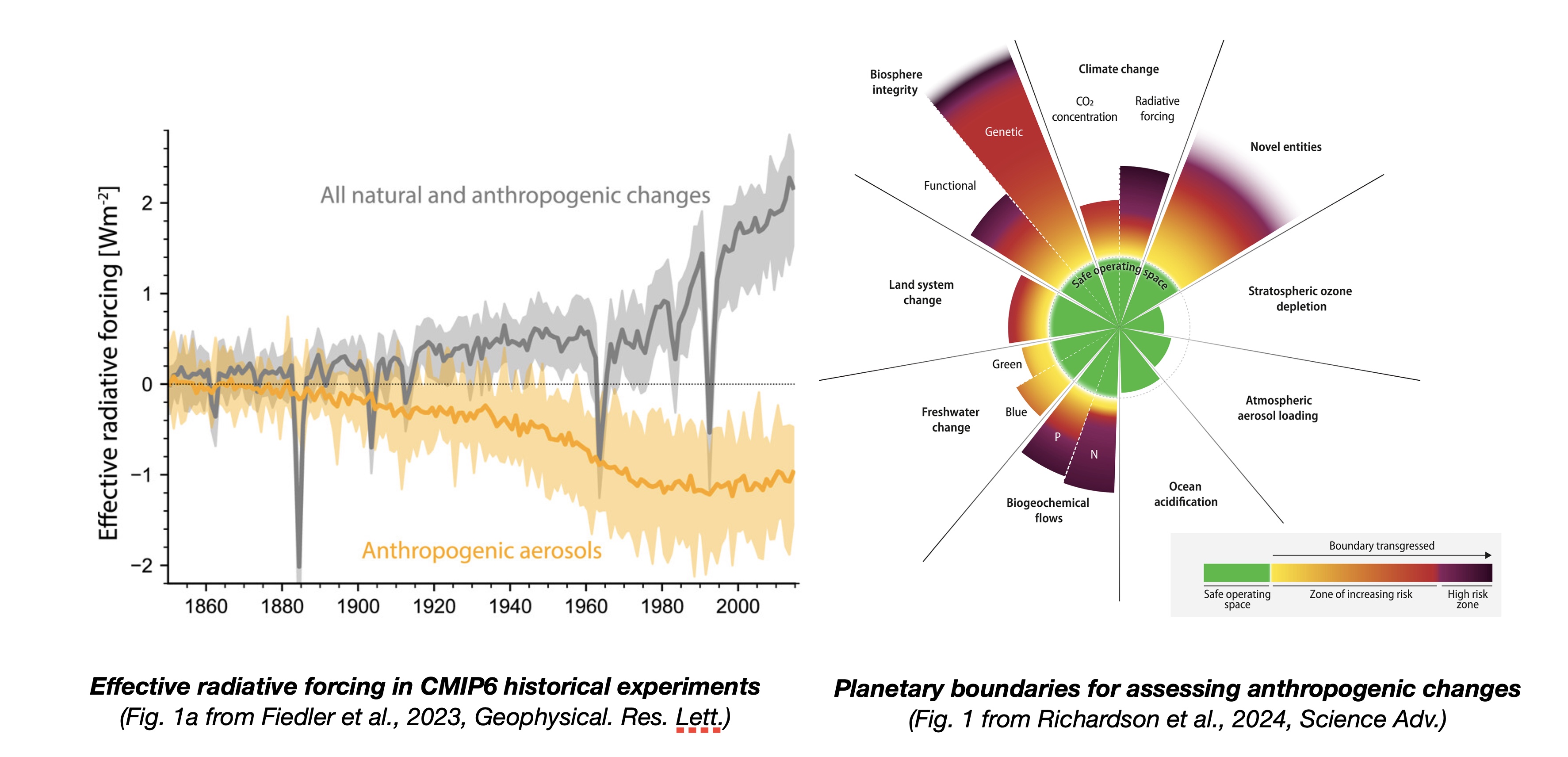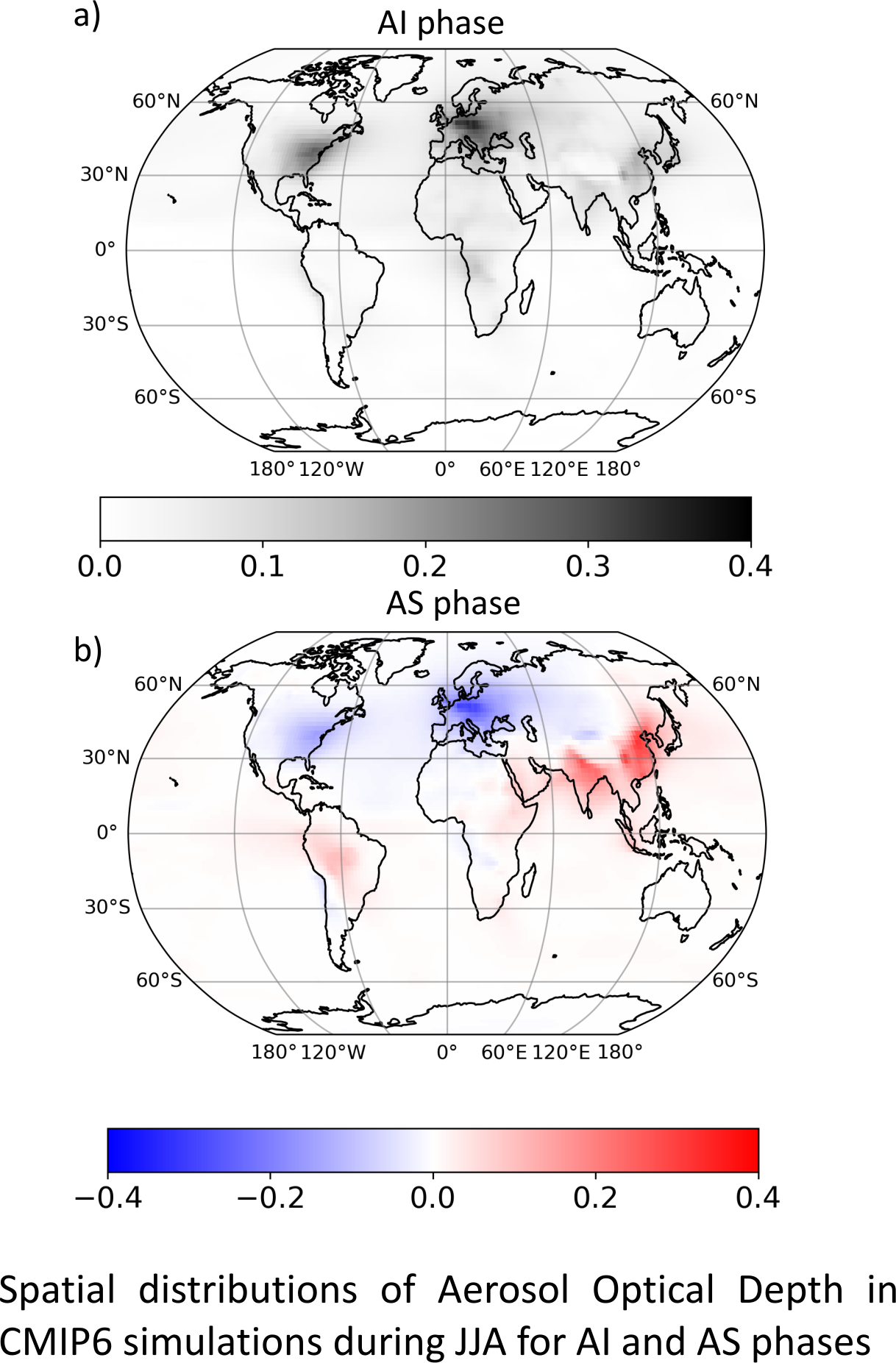B02
Towards a better understanding of moisture responses to radiative forcing
Prof. Dr. S. Fiedler
University of Heidelberg | +49 6221 54-6352 |
Summary
The project B02 systematically assesses the climate forcing and response for atmospheric composition changes from a global perspective and connects to regional studies in the CRC. The project uses output from the Coupled Model Intercomparison Project Phase 6 (CMIP6) paired with observational data, and performs own simulations for desert-dust aerosols and climate change. Moreover, the leading roles in the framework of the CMIP phase 7 (CMIP7) enables the project to provide aerosol forcing data and the new experiment protocol of the new Aerosol and Chemistry Model Intercomparison Project (AerChemMIP2), listed for CMIP7. In so doing, the project contributes to a better understanding of the role of short-lived climate forcers such as aerosol particles in a warmer world.
Graphical summary

Contribution to the CRC
B02 is an essential component of the CRC with connections across the clusters. B02 collaborates with other projects for joint advancements in the understanding of the hydrological cycle with global warming and its links to aerosols. B02 aims to provide valuable insights into land-water-dust changes, and to bridge the gap between regional perspectives in the CRC and global climate change assessments.
Approach
B02's research delved into the analysis of the historical experiments of CMIP6 and the Radiative Forcing Model Intercomparison Project (RFMIP) to pinpoint reasons for model differences for anthropogenic aerosol forcing (Fiedler et al., 2023), and reviewing experimental setups and gaps from three Model Intercomparison Projects (Fiedler et al., 2024, Griffith et al. 2025). The project has taken on leading roles in the preparations for CMIP7 as co-chair of the Aerosol Chemistry Model Intercomparison Project phase 2 (AerChemMIP2) including new land-use change experiments (Fiedler et al., in prep.), as provider of aerosol forcing data for use in CMIP7 (e.g., Fiedler and Sudarchikova, 2024, Fiedler and Azoulay, 2025, Fiedler et al., in review), and as organiser of annual international interdisciplinary CACTI workshops for atmospheric composition, climate response and feedbacks in Germany, USA, and Great Britain since 2023.
The project uses multiple data sources ranging from modeling to observations. Examples are single-forcing experiments from AerChemMIP and the Detection and Attribution Model Intercomparison Project (DAMIP), CMIP6 historical experiments and observational data from satellites to study moisture responses to different climate forcers. While CMIP6 historical experiments consider all known climate forcers, single-forcing experiments only prescribe changes of one climate forcer, e.g., only anthropogenic aerosols are held at pre-industrial levels and all other forcings vary over time. Some of our analyses focus on two interesting time periods: the Aerosol Increase (AI) phase and the Aerosol Shift (AS) phase, which can have similar global forcing but different regional patterns of the radiative effects (e.g., Fiedler et al., 2023). The AI phase was defined as the average difference between the 1970s and the 1850s, when the anthropogenic aerosol emissions have globally increased with most emissions in Europe and North America (below figure). Later, the AS phase characterised the average difference between the 2000s and the 1970s, when anthropogenic aerosol emissions reduced over Europe and North America, but increased in Asia. Moreover, own experiments are performed and analysed. One example are the global simulations of dust emission fluxes using winds from re-analysis and CMIP6 experiments as input for an offline model (Varma, 2024) and experiment with the new CMIP7 model ICON-XPP with updated and extended historical aerosol data (Fiedler and Sudarchikova, 2024, Fiedler and Azoulay, 2025).
Main Results in 2022-2025
- CMIP6 multi-model consensus on wetting and drying patterns in historical experiments can be regionally misleading (Jensen et al., 2024)
- Model inter-comparison study on anthropogenic aerosol forcing using CMIP6 historical experiments and RFMIP experiments with the same aerosol parameterization across different models documented changes and reasons for model differences in aerosol forcing (Fiedler et al., 2023).
- New aerosol boundary in planetary boundaries framework has been evaluated to be regionally but not globally transgressed (Richardson et al., 2023).
- Regional dust bowl assessment completed by quantifying risks for land degradation due to soil erosion by wind and water using machine learning (Bouroughani et al., 2023).
- Machine learning method was developed to reconstruct cloud-obscured dust plumes in satellite images (Kanngießer and Fiedler, 2024).
- Simulations of the historical dust emissions have been finished using 3-hourly winds from ERA5 and CMIP6 historical experiments, published via the DETECT database (Varma, 2024).
- New aerosol forcing data has been produced and published, which are consistent with updated and extended emissions as used in CMIP6plus (Fiedler and Sudarchikova, 2024) and CMIP7 (Fiedler and Azoulay, 2025).
- A review of the use of AerChemMIP experiments for climate and air quality research was completed (Griffith et al., 2025) and informs the experimental design of AerChemMIP2 (Fiedler et al., in prep.), which is a basis for planned work in the 2nd phase.

Data
Fiedler, S., & Azoulay, A. (2025). CMIP7 Climate Forcings Dataset: Simple plumes for anthropogenic aerosols (SPv2.1) [Data set]. Zenodo. https://doi.org/10.5281/zenodo.15283189
Fiedler, S., & Sudarchikova, N. (2024). CMIP Climate Forcings Dataset: Simple plumes for anthropogenic aerosols (Version SPv2) [Data set]. Zenodo. https://doi.org/10.5281/zenodo.14512962
Varma, V. (2024). Dust emission based on CMIP historical experiments [Data set]. DETECT database
Publications
Jensen, L., Gerdener, H., Eicker, A., Kusche, J. and Fiedler, S. (2024) Observations indicate regionally misleading wetting and drying trends in CMIP6. npj Climate and Atmospheric Science, 7 (1). Art.Nr.: 249. DOI 10.1038/s41612-024-00788-x.
Griffiths, P. T., Wilcox, L. J., Allen, R. J., Naik, V., O'Connor, F. M., Prather, M., Archibald, A., Brown, F., Deushi, M., Collins, W., Fiedler, S., Oshima, N., Murray, L. T., Samset, B. H., Smith, C., Turnock, S., Watson-Parris, D., and Young, P. J.: Opinion (2025) The role of AerChemMIP in advancing climate and air quality research, Atmos. Chem. Phys., 25, 8289–8328, https://doi.org/10.5194/acp-25-8289-2025.
Fiedler, S. , Naik, V., O'Connor, F. M., Smith, C. J., Pincus, R., Griffiths, P., Kramer, R., Takemura, T., Allen, R. J., Im, U., Kasoar, M., Modak, A., Turnock, S., Voulgarakis, A., Watson-Parris, D., Westervelt, D. M., Wilcox, L. J., Zhao, A., Collins, W. J., Schulz, M., Myhre, G. and Forster, P. M. (2024) Interactions between atmospheric composition and climate change – Progress in understanding and future opportunities from AerChemMIP, PDRMIP, and RFMIP. Open Access Geoscientific Model Development, 7 (6). pp. 2387-2417. DOI 10.5194/gmd-17-2387-2024.
Kanngießer, F. and Fiedler, S. (2024) “Seeing” Beneath the Clouds — Machine-Learning-Based Reconstruction of North African Dust Plumes. Open Access AGU Advances, 5 (1). Art.Nr. e2023AV001042. DOI 10.1029/2023AV001042.
Richardson, K., Steffen, W., Lucht, W., Bendtsen, J., Cornell, S. E., Donges, J. F., Drüke, M., Fetzer, I., Bala, G., von Bloh, W., Feulner, G., Fiedler, S. , Gerten, D., Gleeson, T., Hofmann, M., Huiskamp, W., Kummu, M., Mohan, C., Nogués-Bravo, D., Petri, S., Porkka, M., Rahmstorf, S., Schaphoff, S., Thonicke, K., Tobian, A., Virkki, V., Wang-Erlandsson, L., Weber, L. and Rockström, J. (2023) Earth beyond six of nine planetary boundaries. Open Access Science Advances, 9 (37). Art.Nr. eadh2458. DOI 10.1126/sciadv.adh2458.
Boroughani, M., Mirchooli, F., Hadavifar, M. and Fiedler, S. (2023) Mapping land degradation risk due to land susceptibility to dust emission and water erosion. Open Access SOIL, 9 (2). pp. 411-423. DOI 10.5194/soil-9-411-2023.
Fiedler, S. , van Noije, T., Smith, C. J., Boucher, O., Dufresne, J., Kirkevåg, A., Olivié, D., Pinto, R., Reerink, T., Sima, A. and Schulz, M. (2023) Historical Changes and Reasons for Model Differences in Anthropogenic Aerosol Forcing in CMIP6. Open Access Geophysical Research Letters, 50 (15). Art.Nr. e2023GL104848. DOI 10.1029/2023GL104848.

